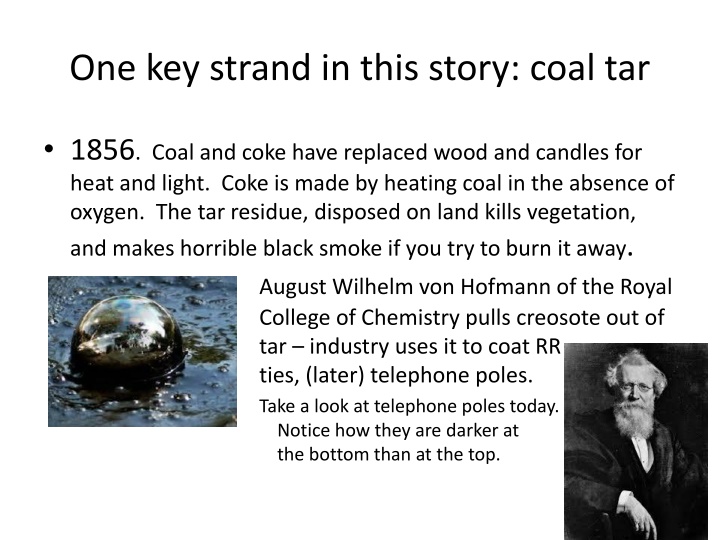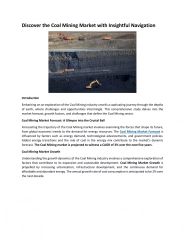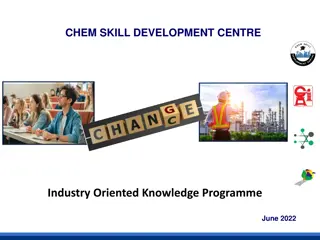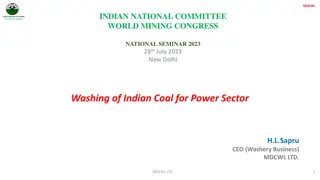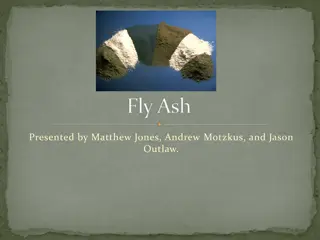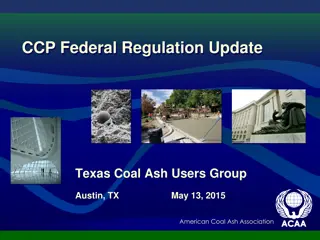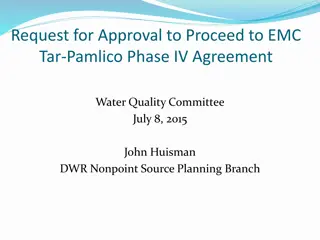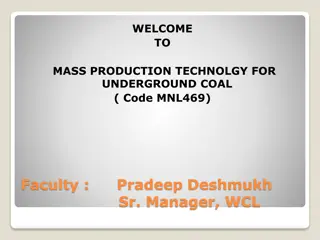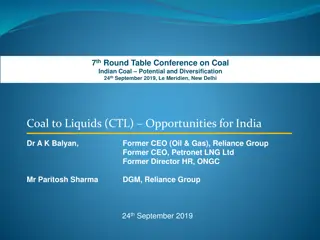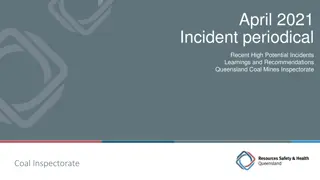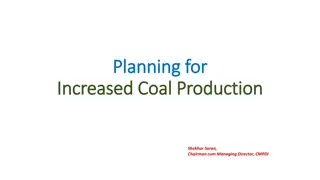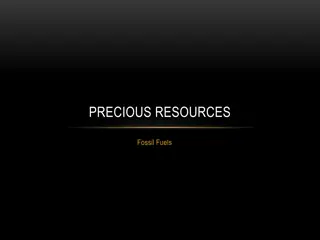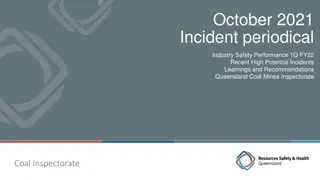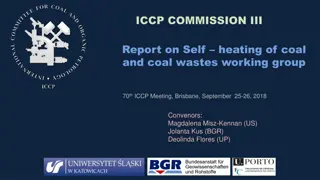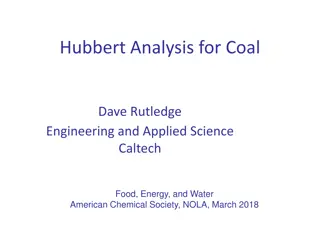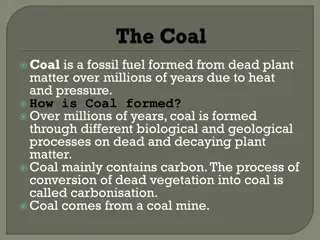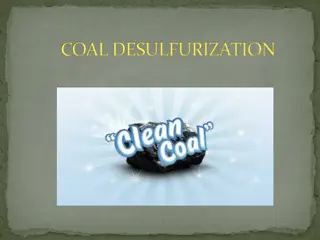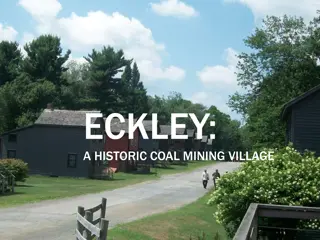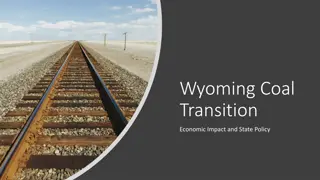Evolution of Chemical Industry from Coal Tar to Environmental Regulations
The story traces the evolution of the chemical industry from the discovery of coal tar in 1856 to the development of aniline dyes, resulting in the growth of major chemical companies. However, the environmental impact became a concern, leading to the Toms River Superfund Site and the implementation of regulations like RCRA and CERCLA to manage hazardous waste.
Uploaded on Sep 25, 2024 | 3 Views
Download Presentation

Please find below an Image/Link to download the presentation.
The content on the website is provided AS IS for your information and personal use only. It may not be sold, licensed, or shared on other websites without obtaining consent from the author.If you encounter any issues during the download, it is possible that the publisher has removed the file from their server.
You are allowed to download the files provided on this website for personal or commercial use, subject to the condition that they are used lawfully. All files are the property of their respective owners.
The content on the website is provided AS IS for your information and personal use only. It may not be sold, licensed, or shared on other websites without obtaining consent from the author.
E N D
Presentation Transcript
One key strand in this story: coal tar 1856. Coal and coke have replaced wood and candles for heat and light. Coke is made by heating coal in the absence of oxygen. The tar residue, disposed on land kills vegetation, and makes horrible black smoke if you try to burn it away. August Wilhelm von Hofmann of the Royal College of Chemistry pulls creosote out of tar industry uses it to coat RR ties, (later) telephone poles. Take a look at telephone poles today. Notice how they are darker at the bottom than at the top.
His student William Perkin tries to pull quinine (for malaria, to replace cinchona bark from Peru) from tar He gets black goo, washes it out of the test tube, sees a brilliant purple clinging to the glass, wipes it with alcohol, and sees it has now transferred to the cloth => aniline dyes. Tyrian purple, derived from molluscs, was known as Royal Purple in ancient times. It was rare and reserved for royal use. Now any fashionable middle class lady could have it. The 1890 s became known as the Mauve Decade . Emperor Justinian
The industry grows and comes here Ciba-Geigy, BASF, Bayer, Hoechst, Dow, etc. the organic chemical industry grows from making products out of what was waste from fossil fuel use. 1864 city of Basel orders a Geigy plant closed and successfully sues for poisoning of water, soil, and people. Evidence mounts that coal tar derivatives benzene, toluene, napthalene, acids, solvents are injuring workers as well but the industry spreads. American tariffs are high so they start locating production in America. Cincinnati Chemical Works makes dyes for military uniforms and DDT. Fouling of Ohio River Congressional hearings from 1936 1945. Ciba (part of CCW) moves to Toms River, NJ. Fractional Distillation a basic operation in organic chem. mfg (petroleum refining example)
The result The Toms River Superfund Site Dan Fagin writes in Toms River (2013) about the filter cake, still bottoms and other residues: Where to put it? Ciba made the cheapest and most obvious choice, if not the safest one. The company would get rid of its solid waste in Toms River in the same way it had in Basel (at first) and the same way its competitors did at their own plants if they were lucky enough to have sufficient room. Ciba would dump it on the factory grounds all of it, enough to fill more than a thousand fifty-five gallon drums every year. (By the late 1970s, the annual total would be closer to ten thousand drums.) (p. 33)
RCRA and CERCLA Barry Commoner: there s no away Encyclopedia Brittanica RCRA imposed management standards on HW generation you must pay to have it shipped by licensed firms, to a licensed destination, you have to store it safely. This raised the costs and reduced generation and irresponsible disposal but companies still make HW. CERCLA imposed liability for when HW or other hazardous substances cause contamination of land or water. This liability is perpetual, retroactive, joint and several, and strict. From Dumping in Dixie, Robert Bullard, 2000
189 Toxic Air Pollutants are regulated under the Clean Air Act https://www.epa.gov/haps/initial-list-hazardous-air-pollutants-modifications EPA is supposed to assess toxics in air to see if we need to tighten up regulations. (The idea of checking on the Residual Risk after regs have been in effect) Population 312,572,412 Cancer Risk per million 31.6890 https://www.epa.gov/national-air- toxics-assessment/2014-nata- assessment-results#emissions
https://www.epa.gov/national-air-toxics-assessment/2014-nata-assessment-https://www.epa.gov/national-air-toxics-assessment/2014-nata-assessment- results#nationwide 1,3 butadiene, benzene, acetaldehyde, chromium, ethylbenzene, napthalene, nickel, carbon tetrachloride, arsenic, and the largest by far, formaldehyde half of which is secondary formation. In less than 1% of census tracts, residents have a cancer risk of greater than 100 in million (one in ten thousand). Ethylene oxide (used to make detergents, thickeners, solvents, plastics, and various organic chemicals, chloroprene (from the production of synthetic rubber) and coke oven emissions
Clean Water Act toxics Broad categories of pollutants originally in 1977 EPA created Priority Pollutants list (forced to by NRDC suit). 129 chemicals some are categories. Has not been updated since. States are to develop numeric limits. 14 states did not, EPA published national limits for them.
From Oliver Houcks The Regulation of Toxic Pollutants under the Clean Water Act (1991) https://elr.info/sites/default/files/articles/21.10528.htm The Clean Water Act prohibits the discharge of toxics "in toxic amounts." Therein lies its flaw. It presumes that we are able to determine what "toxic amounts" are, and to act on that knowledge in the rare event we can make the call. Neither assumption is correct. In fact, after 19 years of struggle, the most effective abatement of toxic pollution has been achieved through technology standards that are not predicated on toxicity at all.
Creeping incorporation of economic considerations Section 112 of the Clean Air Act also requires regulation of toxics to provide an "ample margin of safety. Unable either to include considerations of costs and feasibility in the development of these standards, or as a practical matter to exclude them, EPA did neither relying on its more discretionary authority under the Clean Air Act to pursue other pollution abatement options. By the mid 1980s, with EPA's track record on air toxics every bit as meager as that on water toxics,104 the issue came to a head over the regulation of a particularly well-documented and persistent toxin, vinyl chloride. EPA's adopted standard had frankly considered the economic effects of its proposed control level. In one of the most innovative environmental law decisions from a circuit with a long history of innovation, Judge Bork, writing for the U.S. Court of Appeals for the District of Columbia, distinguished all prior precedent precluding considerations of cost from Clean Water Act toxic standards and from National Ambient Air Standards under the Clean Air Act, and approached the questions of "costs"/"no costs" with Solomon-like pragmatism. What "ample margin of safety" meant was that EPA would set a threshold margin of safety based exclusively on health, but it could then adjust the standard for reasons of cost. However satisfying to the judicial mind, there was no doubt about the message down the line. As one EPA official explained, on remand the Agency was going to arrive at a standard similar to the one it had the first time by "scaling back" its "most conservative assumptions" on the health threshold; but of course, he added, this would be done "in a scientifically credible manner." In practice, health effects would be adjusted to an economically feasible level, as would science. 104. By 1980 EPA had listed only seven toxic air pollutants, and regulated only four; by 1984 EPA had proposed standards for only the remaining three, and listed no more.
Houck recommends Indeed, Congress should fix several timetables, based on relative risk. Science may not be able to set absolute risk numbers, but it can identify categories of greater and lesser risk. Industry can obtain adequate lead time for the necessary process changes. Economists can identify incentives that will encourage industry to arrive on or ahead of schedule. And the engineers can, at last, design for the inevitable. To the extent that certain industries are participating willingly and even aggressively in voluntary pollution prevention and toxic reduction programs, a mandate this firm should only strengthen their hand, and lessen their competitive disadvantage.
How It CAN WORK The critical elements of this alternative are that the mandate, lists, and schedules be made congressional, and therefore beyond litigation, and that they be made firm, When it finally becomes time to make batteries without PCBs, paint without lead, and refrigerants without CFCs, industry finds the way. At which point, ambient levels of these toxins drop precipitously.
Thats one aspect of how one arm of government can work. There are other tools of governance. Technical and Compliance Assistance Education Guidance Grants Subsidies Tax Incentives Recognition Partnership Shared Development Community Assistance Research and Development Site Designations Organization of public engagement and planning Obtaining and providing data Ensuring public access to information and participation in decision-making Developing innovative organizations and businesses Developing needed standards for quality, disclosure, accountability
Right to Know - in OSHA Safety Data Sheets, for workers, but useful for everyone - on state and federal websites on emissions to air and what monitoring tells us - some information about hazardous waste - some information about toxics and haz substances use - some information about storage of dangerous substances, for emergency responders but could be useful to everyone - lots of complex information about water quality - less complex information about water discharges - FOIA and state public documents laws - FACA and state open meetings laws - In adversarial proceedings, notice of all opportunities to be heard by the court and of motions of opposing parties - public notice of local development, taking down of trees - disclosure of material facts in real estate being sold or rented, such as lead - notice of opportunities to vote and be heard in public hearings - disclosure of conflicts of interest, real and/or potential ,
Safety Data Sheets https://www.osha.gov/sites/default/files/publ ications/OSHA3514.pdf
Toxics Release Inventory - Annual reports that people once paid a lot of attention to 21,557 facilities reported to TRI for 2018 Most releases were in the form of land disposal, primarily from metal mining operations Since 2007, releases decreased by 9%
The original idea - TSCA Meant to control pollution risks at the source but as in the opera, it ends badly
The Useless Form U and what it could do It asks manufacturers to answer for Processors as to whether the chemical is used for b. Consumer or Commercial (purposes) or both c. Used in Products Intended for Children? d. Percent Production Volume e. Maximum Concentration f. Number of Commercial Workers Reasonably Likely to be Exposed Manufacturers can say I Don t Know . WHY HAVE MANUFACTURERS fill this out? Have them fill out the first part which tells about the chemical information THEY HAVE and then have them submit that to an electronic database. Let the processor then fill out the rest. Let the form follow the chemical.
The P2 Revolution Drag out reduction in metal plating
Hydrogen peroxide based cleaners Substitute for chlorine-based, other toxics I use the 3% Hydrogen Peroxide and no longer have to worry about my dogs having residual traces of chemical cleaners on the floors,etc that they may get on their feet,or fur that they may lick off and get sick from. Testimony at The Greenest Dollar
Immortal etchants Acids used to make wiring boards, decorative metal products Can extend their useful life by maintaining constant pH precisely Several methods of reversing the oxidation/ reduction chemical process Regeneration or life extension found to be widely feasible but few were doing it because disposal was cheap
Risk in the Context of Relationship You can calculate the severity of risk all you want, but I don t think you have the right to impose risks on me. RISK IMPOSITION is a value question. RISK ASSESSMENT can be a dodge of the more important question. It is hubristic to think we can actually calculate risk with precision. We mislead ourselves by looking at risk in a vacuum. Risks exist in combination. We should simply adopt the moral strategy of reducing risks where we can. The existence of risk does give rise to a responsibility to investigate and to try to reduce the risk. We should only use Acceptable Risk as a temporary compromise while working to reduce risks. If someone says you are unrealistic to articulate the precautionary principle, because we cannot expect to live in a risk-free world, ask them if they think we should have the right to choose our own risks? Or is that something others should do for us? Ask them if you served them a glass of wine having one part per billion sewage in it (without telling you), would that be ok, given that there is no medical evidence that that level will harm you? Or would they rather you told them and gave them the choice not to drink it?
Elements of A Detoxification Agenda 1. 2. 3. 4. 5. 6. Restore Impacted Communities Ban Never Chemicals Fund SDWA testing and provision everywhere Fund updating CWA treatment everywhere Restore funding to state enforcement programs Provide funding and assist states in providing technical, financial and compliance assistance to greening industry Ensure expertise is available to every community and citizens on knowing how to purchase green, live green, work green, and more safely consume Work with community development corporations on healthy housing and development Operationalize environmental justice Prevent industry dominance in policy-making at all levels Operationalize responsibility Remove Preemption 7. 8. 9. 10. 11. 12.
More Items for the Agenda 13. Institute ALARA 14. Shift the burden of proof 15. Engage communities in planning 16. Build Toxics Recognition and Prevention into Health Care, Housing, Purchasing 17. Reclaim International Leadership 18. Make the form follow the chemical so we have universal tracking of hazardous substance movements 19. Work with every hazardous industrial sector to continuously reduce hazards 20. Reward risk sources for risk reduction through insurance rebates and other means 21. Initiate public-private partnerships to develop green alternatives and keep a public share in what is developed so that the green alternatives will both provide business incentives and be available to everyone at reasonable prices create shared intellectual capital in such public-private partnership green alternative development. 22. Counter propaganda and political action against regulation by convening regular public discussion of the information of concern and the options for reducing risks, potential and real, as continuous business as usual, of concern to both private and common bodies.
